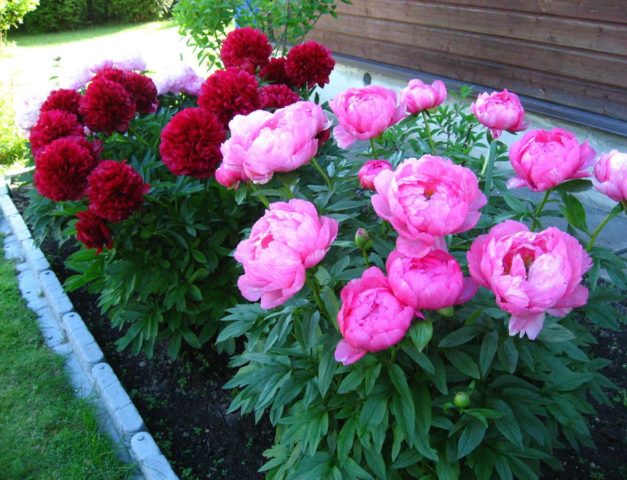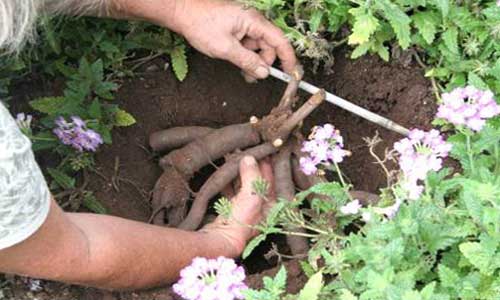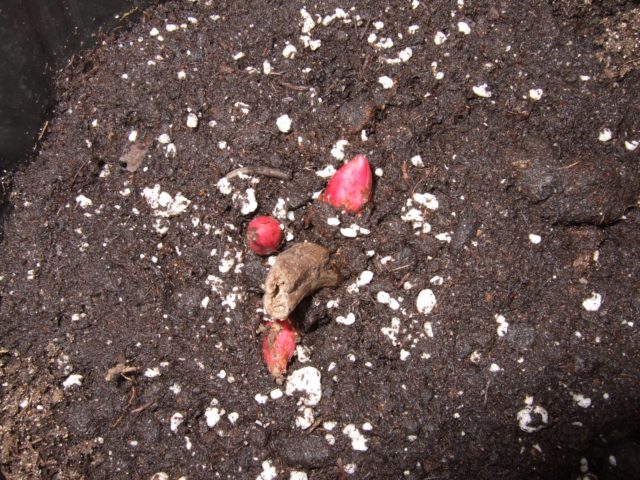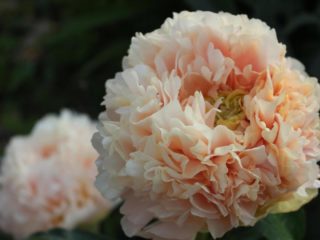Content
Peony Paula Fey is an interspecific hybrid created in the 70s of the last century in the USA. The variety was awarded the gold medal of the American Peony Society for its abundant flowering and bright color. This is a common crop in Russian gardens, which can also be grown in greenhouse conditions.
Description of peony Paula Fey
Variety Paula Fey is a herbaceous compact shrub that grows up to 80-85 cm in height. It forms a crown with a diameter of about 50 cm. Peony is characterized by intensive shoot formation and grows well. The first bud formation occurs in the third year of growth.
Externally, the Paula Fey hybrid looks like this:
- the peony bush is dense, not spreading, holds its shape well without additional tying to a support;
- The stems are tough, erect, smooth, and light green in color. In rainy weather, when the flowers become heavy from moisture, the tops may droop slightly;
- the leaves are arranged alternately, on one petiole there are 6 opposite leaf plates;
- The leaf shape is lanceolate with a pointed tip, smooth edges and a glossy surface. There is slight pubescence in the lower part. Foliage color is dark green;
- The peony's root system is mixed, fibrous, grows up to 50 cm in diameter, and penetrates the soil to a depth of 60 cm.
The mixed type of root fully supplies the plant with moisture and nutrition. Thanks to its significant deepening, the peony overwinters well without additional shelter. The Paula Fey hybrid differs from other representatives in its high frost resistance and can withstand temperatures down to -33°C.
Paula Fey is a priority when choosing varieties for gardeners in Siberia, the Middle and European regions. Peony is in high demand in the Moscow region and is found in areas of the Leningrad region. The plant is grown in all regions of the North Caucasus. According to the degree of frost resistance, the crop belongs to the 4th climatic zone.
Features of flowering
Peony is an early variety that blooms in mid-May. Flowering duration is about 15 days. The buds are formed on the tops and side shoots; there can be up to three flowers on one stem; their life cycle is one week. After the flowering phase is completed, the Paula Fey hybrid retains its green mass until frost; in late autumn the leaves turn dark burgundy, then the above-ground part dies.
Peony milky-flowering Paula Fay is a representative of the semi-double type:
- the flowers are formed by petals arranged in five rows. The lower ones are prostrate, and closer to the center - half-open;
- the core is dense, consisting of numerous stamens with orange anthers;
- petals are rounded with wavy edges and corrugated surface;
- the flowers are glossy, dark pink with a coral tint that changes depending on the lighting;
- The flower shape is round, lush, diameter is about 20 cm.
The abundance of Paula Fey flowering depends on the location and sufficiency of nutrition. In the shade, the flowers do not fully open; they are smaller in size and pale in color. If the peony does not have enough nutrition or moisture, it may not bloom.
The Paula Fey variety is grown for cutting to obtain lush inflorescences; the side stems with second-order buds are removed.
Application in design
The interspecific form of herbaceous peony was created for decorative gardening. Paula Fey is ideally combined with all early flowering plants and evergreen shrubs: dwarf and groundcover conifers, yellow tulips, roses with dark-colored flowers, daylilies, bladderwort, irises, daffodils, hydrangea.
Do not place the peony in the shade of large trees with a dense crown. Constant lack of light and high humidity negatively affect vegetation and flowering. Paula Fey cannot stand being next to plants with a creeping root system, because competition for food will not be in favor of the peony.
The culture is bred for open ground, but if full lighting is created, peony can be grown in large pots on a balcony, loggia, or decorated with a closed veranda. If the biological requirements are not met, the flowers of the Paula Fey variety will not fully open; in the worst case, the peony will not bloom.
Several examples (with photos) of the use of Paula Fay peony in ornamental gardening:
- as a border option, peonies of different colors are planted around the perimeter of the flowerbed;
- decorate the central part of the flower bed;
To make the peony bush more compact, install a decorative support
- used solo or in a mix of different varieties to decorate lawns;
In mass planting, Paula Fey is placed next to white or cream-colored varieties
- grown on farms;
- used in mass planting to design a recreation area;
- to create a color accent in the foreground of large trees;
- planted together with flowering crops near the fence;
Peony harmonizes with any flowering plants and shrubs, as long as they do not shade it
Reproduction methods
The hybrid crop is not propagated generatively, because the germination of the material is poor, and the shoots from the seeds do not retain varietal qualities. For Paula Fey, a vegetative method is possible, but cuttings and layering do not take root well, at least three years pass before flowering, so this method is considered ineffective.
The peony grows quickly, takes root well in a new area, and produces many young root tubers.
Landing rules
Hybrid Paula Fay tolerates low temperatures and can be planted before winter or in spring. Peony is an early plant, so placing it on the site at the beginning of the growing season will delay flowering by a year. Gardeners most often practice autumn propagation by planting the plant in mid-September. In spring, the peony will quickly gain green mass and produce its first buds.
Landing site requirements:
- fully illuminated. Even partial shade is not allowed, because the peony stops forming new shoots, the flowers become small, do not open fully, and lose their brightness of color;
- the soil is neutral, fertile, well aerated, without stagnant water;
- the soil is sandy loam or loamy;
- good air circulation.
A month before planting, in the area allocated for Paula Fey, if necessary, adjust the soil composition to neutral. On acidic soil, the peony's immunity decreases; on alkaline soil, vegetation slows down. A hole 60 cm deep and 50 cm wide is prepared in advance so that the soil has time to settle. The bottom is covered with drainage and peat mixed with compost. Peony responds well to organic matter; there is never too much fertilizer for a crop of this type.
Paula Fey is planted shallowly, so before planting, prepare a fertile mixture of turf layer and humus, add superphosphate and potassium. Fill the hole until about 15-20 cm remains to the edge and fill it with water.
If the seedling is purchased in a transport pot, it is placed in a hole along with a lump of earth. In the case of planting in a plot from the mother bush, the root is inspected, weak areas and dry fragments are carefully removed so as not to damage the young shoots. Dip into clay solution.

A peony plot should consist of five vegetative buds
Planting the variety Paula Fey:
- The dimensions of the hole are adjusted; it should not be deep or, on the contrary, shallow; the buds cannot be deepened below 4 cm.
- Install the bar on the edges of the recess.
Add soil so that the buds are 4 cm deep in the ground.
- Place the peony in the hole at an angle of 450 and fix it to the bar so that when the ground settles, the plant does not go deeper.
- Carefully sprinkle sand and substrate on top; if there are young shoots, they are left on the surface.
- The soil is lightly compacted and the peony is watered.
The above-ground part is cut off, the root circle is mulched.If planting is in autumn, then the fixing bar is removed at the beginning of summer, after spring work - in the fall. When placing bushes in one line, maintain a distance between holes of 120-150 cm.
Aftercare
Caring for herbaceous peony variety Paula Fey:
- To maintain moisture on the soil surface around a peony bush with a diameter of approximately 25 cm, cover the soil with mulch. Every spring the material is renewed, and in the fall the layer is increased.
- Watering of the Paula Fey hybrid begins in the spring, when a stable above-zero temperature has established, and continues until mid-July. The frequency depends on precipitation; on average, a peony needs 20 liters of water per week. Do not allow moisture to stagnate.
- If there is no mulch, when a crust forms, the soil is loosened, while weeds are removed by the roots.
- In early spring, the peony is fed with nitrogen-containing agents and potassium phosphate. Phosphorus is added during the budding period. When Paula Fey blooms, the plant is fertilized with organic matter; nitrogen is not used during this period.
Preparing for winter
Before frost, the stems are cut off, leaving about 15 cm above the ground. The plant is watered abundantly, the layer of mulch is increased, and fed with organic matter. After autumn planting, it is recommended to cover young seedlings with straw, then with burlap, and in winter make a snowdrift over them.
Pests and diseases
Paula Fey gets sick very rarely. The hybrid has stable immunity to all types of infection. Only with insufficient aeration and drainage can a peony be affected by gray rot or powdery mildew. The plant must be treated with Fitosporin and moved to another place.
Among insects, Paula Fey is parasitized by the bronze beetle and root-knot nematode.Get rid of pests with Kinmiks.
Conclusion
Peony Paula Fey is an early flowering herbaceous shrub. A hybrid variety created for ornamental gardening. The plant has strong immunity. Bright semi-double flowers of a coral shade are combined with all types of plants with similar agricultural technology and biological requirements.
Reviews of peony Paula Fey



















